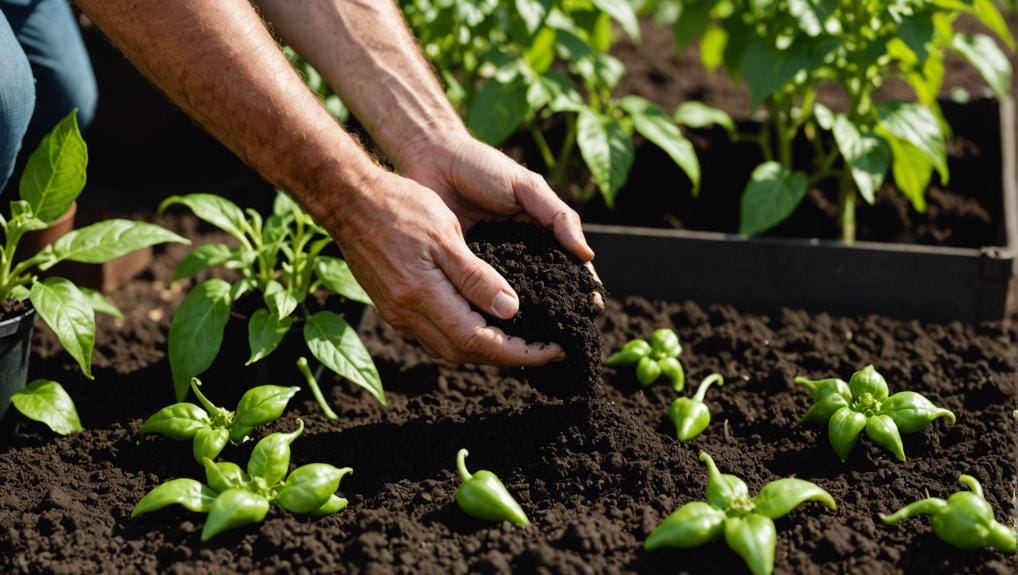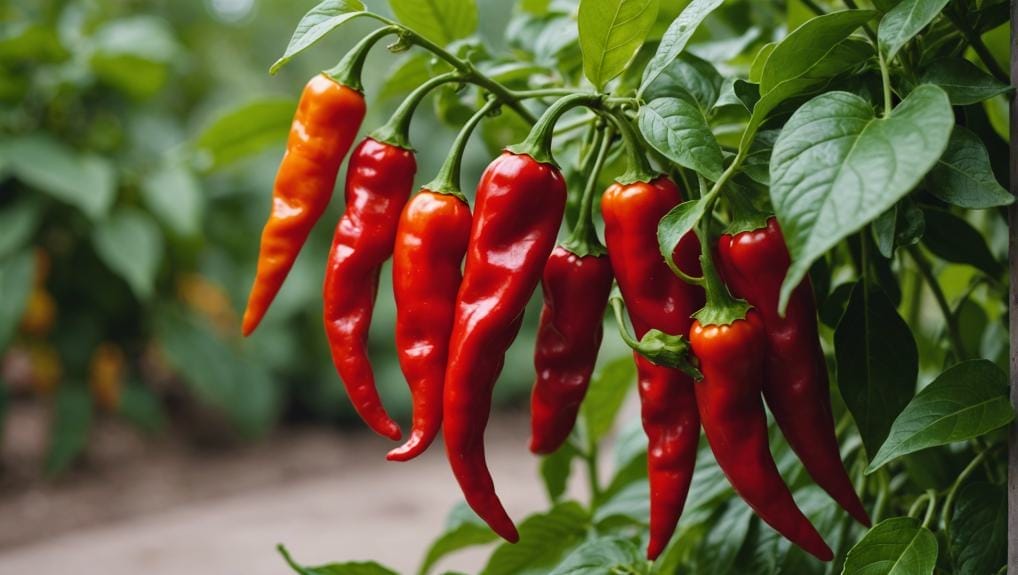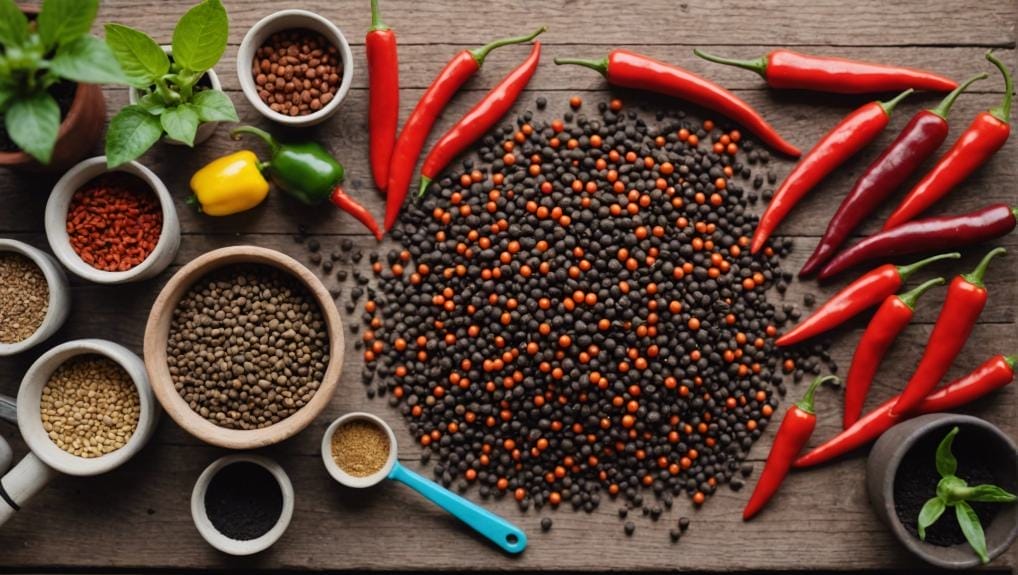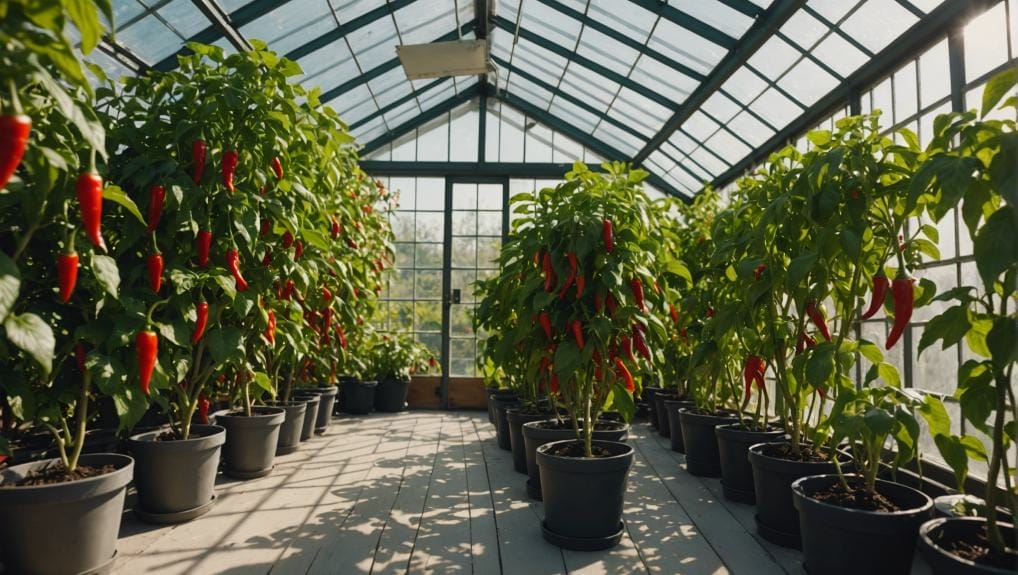When it comes to growing hot peppers, ensuring the right balance of nutrients is crucial for optimal plant health and productivity. Imagine having vibrant plants laden with fiery fruits, all thanks to a well-thought-out fertilization plan.
But what if there’s more to it than just feeding your plants? What if the key lies not only in what you feed them but also in how and when you do it? Stay tuned to uncover the secrets that could take your hot pepper garden to the next level.
Understanding Hot Pepper Nutritional Needs
To grow thriving hot pepper plants, you must grasp the essential nutritional requirements they demand. Hot pepper plants rely on a balanced mix of nitrogen for robust leafy growth, phosphorus for strong root development, and potassium for producing quality fruit. Understanding these nutritional needs is key to ensuring your plants reach their full potential in terms of fruit production and overall health.
Proper fertilization plays a vital role in meeting the nutritional needs of hot pepper plants. By providing the right balance of nutrients throughout the growing season, you can support healthy root systems, vibrant foliage growth, and bountiful fruit yield. Neglecting these essential nutrients can lead to issues like weak root systems, poor fruit quality, and decreased overall plant health.
Importance of Nitrogen, Phosphorus, Potassium
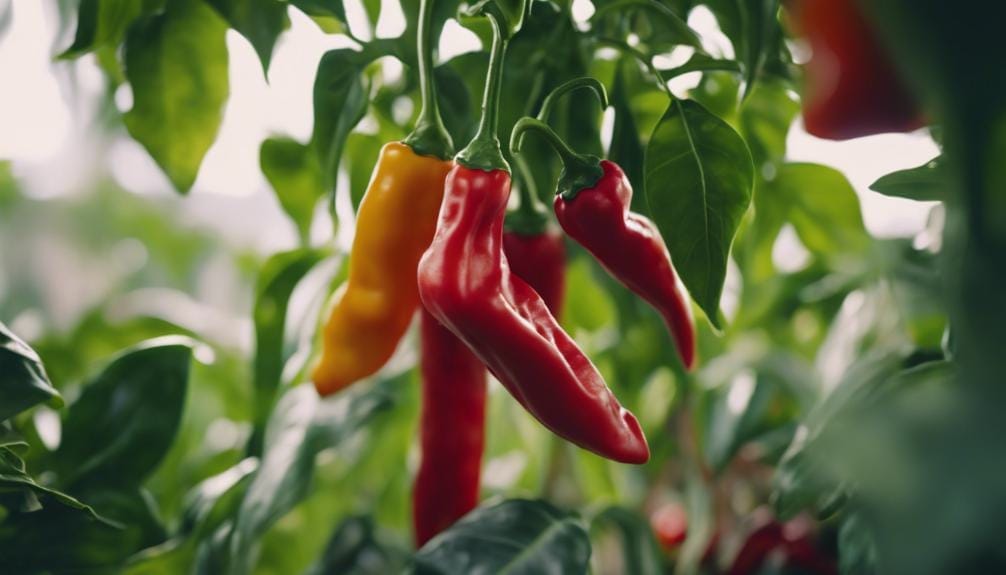
Promoting robust growth and fruit development in hot pepper plants, nitrogen, phosphorus, and potassium play vital roles in ensuring overall plant health and productivity.
Nitrogen, crucial for leafy growth, helps develop lush foliage essential for photosynthesis in hot pepper plants. Phosphorus strengthens the root systems, providing stability and enhancing efficient nutrient uptake.
Potassium, on the other hand, contributes to the quality of fruits by improving taste, color, and shelf life. Maintaining a proper balance of these nutrients is key to maximizing growth and yield.
Monitoring and adjusting the levels of nitrogen, phosphorus, and potassium are essential to prevent deficiencies or excesses that could hinder the growth and productivity of hot pepper plants. By ensuring the right nutrient balance, you can support healthy plant development and encourage optimal fruit production in your hot pepper plants.
Choosing Organic Vs. Synthetic Fertilizers

When deciding between organic and synthetic fertilizers for your hot pepper plants, consider the benefits and drawbacks of each to make an informed choice.
Organic fertilizers, derived from natural sources like compost and manure, provide slow-release nutrients that promote soil health and long-term sustainability in hot pepper cultivation. On the other hand, synthetic fertilizers, chemically manufactured with precise nutrient ratios, offer quick nutrient uptake for hot pepper plants, potentially enhancing fruit production.
Organic fertilizers support microbial activity in the soil, while synthetic fertilizers may lead to chemical build-up over time, causing nutrient imbalances and environmental concerns.
Choosing between organic and synthetic fertilizers depends on your preferences and desired outcomes in hot pepper growth. If you prioritize sustainability and soil health, organic fertilizers are the way to go. However, if you seek rapid nutrient availability and precise control over nutrient ratios, synthetic fertilizers might be more suitable. Consider these factors when selecting the best fertilization approach for your hot pepper plants.
Starting Your Fertilization Schedule
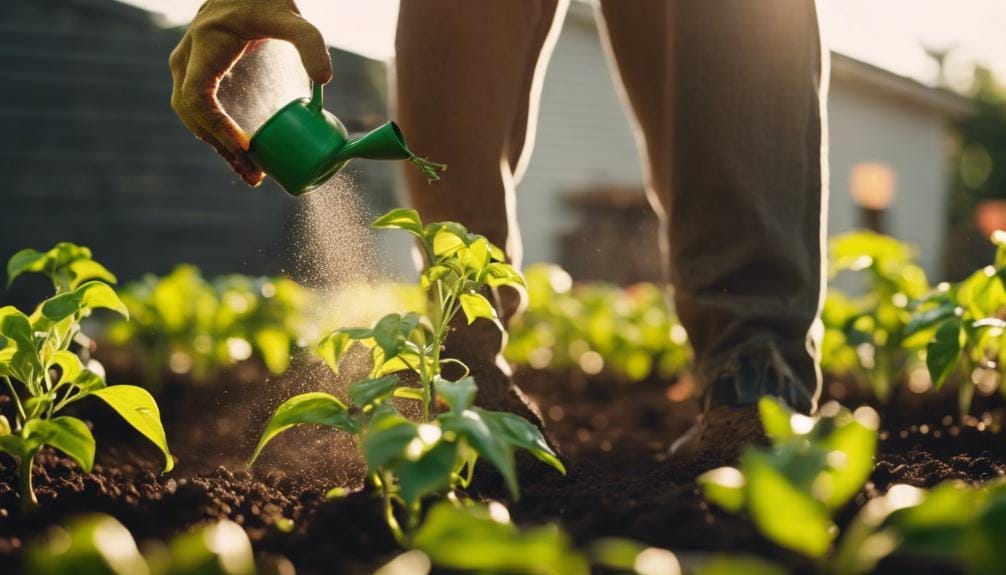
Consider the growth stage of your hot pepper plants before initiating your fertilization schedule. Once your plants have established a strong root system, usually around 3-4 weeks after planting, it’s time to start fertilizing.
Opt for a balanced fertilizer with an N-P-K ratio of 10-10-10 or similar to provide the necessary nutrients for healthy plant growth. During the growing season, apply the fertilizer every 2-3 weeks, adjusting the frequency based on how your plants are responding.
Be cautious not to over-fertilize your hot peppers as this can result in nutrient imbalances, stunted growth, and decreased fruit production. Keep an eye on your plant’s growth and leaf color as indicators of their health.
Types of Fertilizers for Hot Peppers

Looking for the best fertilizers for your hot peppers to ensure optimal growth and fruit production?
When it comes to fertilizing hot peppers, you have several options to choose from. Organic fertilizers like compost, fish emulsion, and aged chicken manure are excellent choices due to their slow-release nutrients, providing a steady supply of essential elements to your plants.
On the other hand, synthetic fertilizers with balanced N-P-K ratios can deliver immediate nutrition during critical growth stages, aiding in robust plant development. Water-soluble fertilizers are convenient for quick uptake by hot pepper plants, especially when they’re flowering and fruiting.
If you prefer a long-lasting solution, slow-release granular fertilizers offer a continuous nutrient supply over an extended period, promoting consistent growth. Additionally, liquid fertilizers such as seaweed extracts or compost teas provide a rapid nutrient boost to your hot peppers, enhancing overall plant health.
Consider your preferences and the specific needs of your hot pepper plants when selecting the right fertilizer for them.
Correct Application of Fertilizer
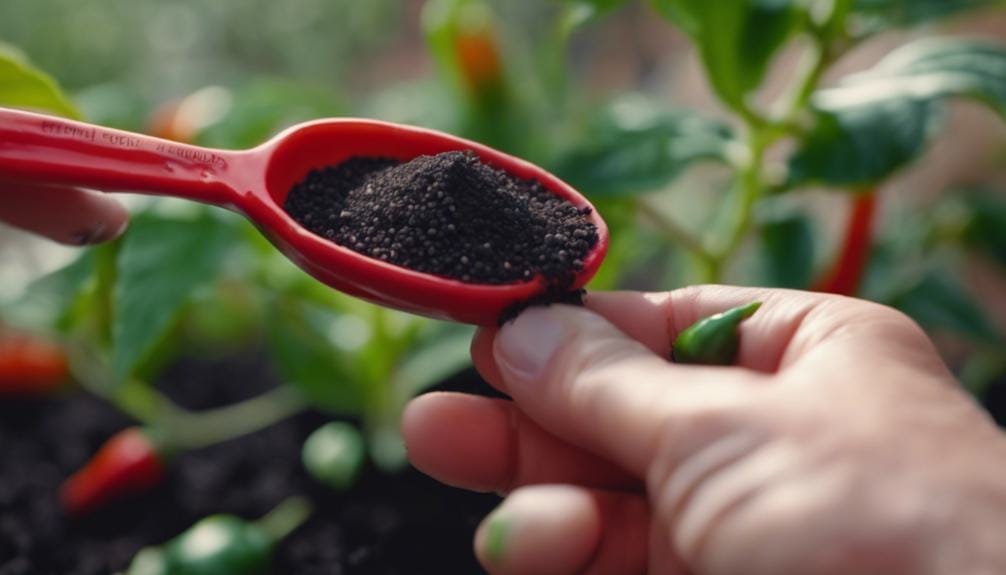
To ensure optimal growth and fruit production for your hot peppers, mastering the correct application of fertilizer is key. Proper application involves following manufacturer instructions for dilution ratios and frequency.
Evenly distribute fertilizer around the base of the plant to ensure all roots receive adequate nutrients. Avoid over-fertilizing, as it can lead to nutrient imbalances, root burn, and decreased fruit production.
Apply fertilizer during cooler parts of the day to prevent nutrient loss through evaporation. Regular soil testing helps determine specific growing needs and guides the application of fertilizers tailored to your hot pepper plants.
Consider factors like bone meal for calcium, the NPK ratio for balanced nutrition, and the importance of organic matter for soil structure and plant health. By understanding the nutrient needs of your hot pepper seeds and plants, you can apply fertilizer effectively to promote robust growth and bountiful harvests.
Maximizing Pepper Plant Growth Tips

Maximize the growth of your pepper plants by implementing proper pruning techniques to enhance air circulation and sunlight exposure, leading to healthier plants and increased yields. Understanding the nutritional needs of your pepper plants is crucial for maximizing growth.
Fertilizing pepper plants with the right balance of nutrients, including phosphorus (P), potassium (K), and nitrogen (N), throughout the season is essential. Before planting, ensure your soil is well-prepared with the Best Potting Soil to provide a good foundation for your peppers.
To prevent issues like blossom end rot, apply a balanced fertilizer with higher phosphorus content during the flowering and fruiting stages to support root development and pepper production. By monitoring your plants for signs of nutrient deficiencies and adjusting your fertilization schedule accordingly, you can ensure your pepper plants reach their maximum growth potential.
Troubleshooting Pepper Plant Issues
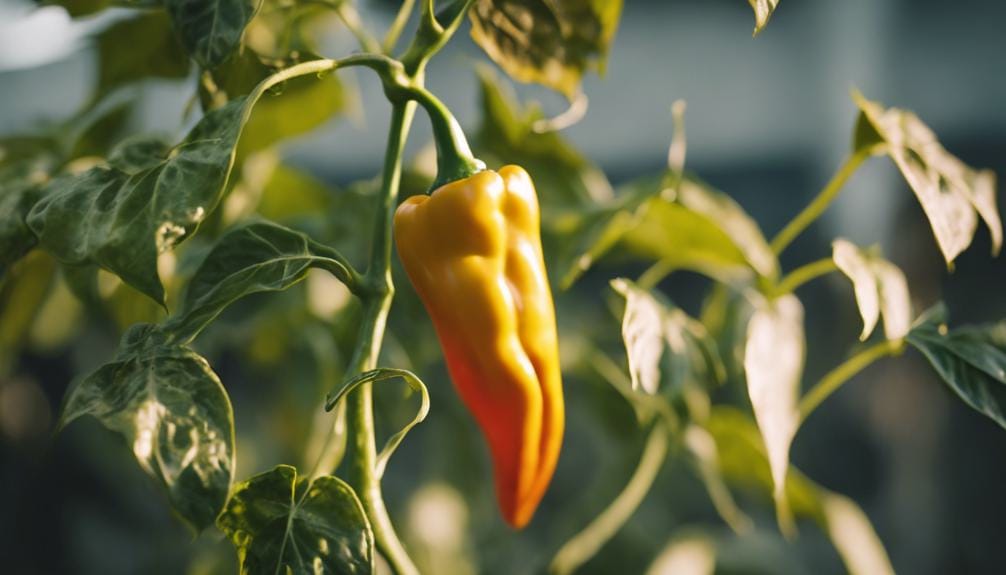
When troubleshooting issues with your pepper plants, identify potential causes such as environmental factors, pests, diseases, and nutrient deficiencies.
Blossom drop may result from high temperatures, low humidity, stress, or inadequate pollination. Common pests like aphids, whiteflies, spider mites, and thrips can be managed with organic pesticides such as Neem Oil. Diseases such as bacterial leaf spot, powdery mildew, and phytophthora blight are often linked to poor air circulation, high humidity, or contaminated soil.
Nutrient deficiencies, like yellowing leaves (nitrogen deficiency) or curled leaves (potassium deficiency), can be resolved through proper fertilization and soil amendments. It’s essential to monitor soil pH levels within the range of 6.0-6.8 to prevent nutrient imbalances and ensure healthy plant growth.
Regularly checking your pepper plants for signs of pests, diseases, and nutrient issues, while providing adequate air circulation, can help maintain their overall health and productivity.
Testing Soil Before Fertilizing

Before applying fertilizers to your hot pepper plants, ensure to test the soil for its pH levels and nutrient content to determine the specific needs of your plants.
Soil testing is essential for understanding the current nutrient levels and pH of your soil, providing valuable insights into the soil composition. By using soil testing kits or professional services, you can accurately assess the soil’s nutrient status and organic matter content. This information is crucial for selecting the right type and amount of fertilizer for your hot pepper plants.
Soil tests reveal any deficiencies or excesses in essential nutrients, guiding you in meeting the specific fertilization needs of your plants. Regular soil testing is key to tailoring fertilization strategies to the unique requirements of hot pepper plants, ultimately promoting healthy growth and ensuring abundant yields.
Make soil testing a routine part of your gardening practices to support the optimal development of your hot pepper plants.
Using Coffee Grounds as Fertilizer
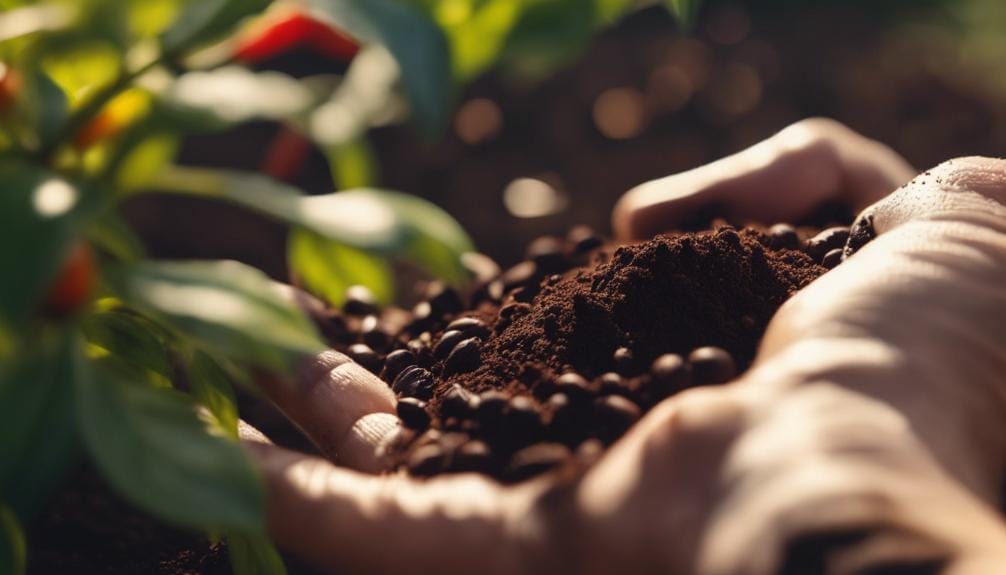
To enhance the growth of your hot pepper plants, consider utilizing coffee grounds as a natural and nutrient-rich fertilizer option.
Coffee grounds serve as a natural fertilizer, supplying hot pepper plants with essential nutrients such as nitrogen, phosphorus, and potassium. The acidity of coffee grounds aids in regulating optimal soil pH levels, supporting hot pepper plant growth and fruit development.
Additionally, these grounds act as a pest repellent, deterring harmful insects like slugs, snails, and ants. It’s crucial to ensure that the coffee grounds used as fertilizer are well-composted to prevent nitrogen competition with plants and reduce the risk of mold growth.
Incorporating coffee grounds into the soil or using them as mulch around hot pepper plants can enhance soil structure, retain moisture, and foster healthy root development. Consider integrating coffee grounds into your hot pepper plant care routine for a natural and beneficial fertilizer option.
Conclusion
In conclusion, by understanding the nutritional needs of hot peppers and choosing the right fertilization approach, you can ensure robust growth and maximize yield.
Remember to test your soil, start a fertilization schedule, and consider using organic fertilizers for healthier plants.
With proper care and attention to detail, you can enjoy bountiful harvests of delicious hot peppers in your garden.
Happy growing!

